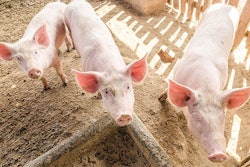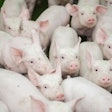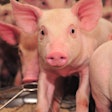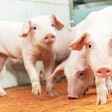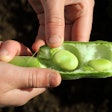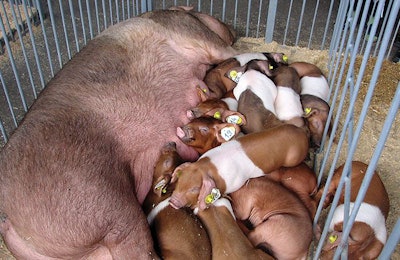
Female breeding pigs (gilts and sows in reproductive age) are fed diets with few if any additives because these animals are not considered as valuable as the growing-finishing pigs (saleable product). On the other hand, additives — or in other terms, ingredients that enhance the value of the feed — are expensive. On the other hand, additives — or in other terms, ingredients that enhance the value of the feed — are expensive. This is because additives require a lengthy and costly research and development phase, and the additives business is rather comfortable with margins traditionally higher than those enjoyed with traditional raw materials.
Sows (all breeding pigs), however, consume about 1,250 kg or more of feed per year, giving a very sizable figure of 1,250 metric tons (MT) of feed per year for a modest farm of 1,000 sows. Now, if one single additive could be sold at such a farm, we are discussing for at least 1.25 MT of product as most additives have an inclusion rate that is at least 1 kg/MT. If we accept the golden rule of 5 euros (or US dollars) for an average commercial additive that is included at the average level of 1 kg/MT, then the cost of such exercise for the farm is 6,250 euros per year. On average, in my experience, sow feeds contain a minimum of three and a maximum of six additives. Doing the math again, the modest farm of 1,000 sows needs to spend from 18,750 to 37,500 euros per year only for the necessary additives to be used in sow feeds. A farm with 10,000 sows will need 10 times this amount of money, and a mega-farm with 100,000 sows will spend almost up to 4 million euros per year, only for sow additives. Take a country like Spain, with 2 million sows, and the potential for the whole sow additives business is the staggering figure of 75,000,000 euros.
Of course, these numbers are nothing compared to the additives business for growing pigs, but this market is saturated with products, exhausted by over-information and suffering from cheap copies. So, although the figures there are better, margins and market penetration are weak, especially for new players (either with new products or new marketing efforts). In contrast, the market for sow additives is only now picking up speed, if only because poor management/labor and super-prolific genetics do not make a good match, leaving a sizeable gap that can be alleviated (in part) by nutrition. And because nutrition is difficult and time consuming for most to master, additives come to the rescue; hence their potential to enhance the value of an otherwise mediocre nutrition program.
Having accepted reality and commercial conditions, and in need of a quick solution, one is forced to ask what additives really work in sows. Naturally, if we are to consult the brochures and listen to presentations given by additives suppliers, we can be driven to the illogical conclusion that we can get by just by feeding all additives. Here it is fitting to repeat the old joke among nutrition graduate students: If you add up the 10 percent improvement claims from 10 additives, you only need these 10 additives and no natural ingredients to make the perfect feed. Of course, this is not true, but it illustrates the over-importance given to additives in lieu of correct nutrition balance. Additives are tools, like the tools needed to build a house; you still need wood, bricks, cement, etc. Nevertheless, when it comes to additives as tools, the following list includes additives that I have experienced to work in most sow diets — not all together, as each needs to be placed within context of the whole formula.
1. Phytase
We tend to forget that phytase is an additive made mainstream if only because natural phosphate sources have increased in price dramatically the last decade. It is not an additive without any problems, and it pays to do preliminary research before settling on a brand. Not all commercial phytase products are equal. Finally, I would not over-emphasize the role of phytase over that of natural phosphorus sources because bone mineralization is a balancing act that needs careful consideration over the length of the life of a breeding female. So, use phytase, but do not take it for granted.
2. Phytogenics
Phytogenics can solve many problems, as sows suffer from a myriad of problems. They can enhance digestion, boost immunity, help reduce heat stress, improve antioxidation status and even promote gut health — but, not all together; not every product in the market can do all these. Phytogenics come with issues, such as volatility, consistency in concentration, etc. So, even more research is needed to find the right product that works in sows for the right task. There are no miracles to be expected here, just a very useful tool.
3. Heat stress additives
Apart from the phytogenics mentioned above, there are a limited number of additives that come in handy during times of heat distress, especially for lactating or late gestating sows, which understandably suffer the most during heat waves. Such additives include common salt, potassium sulphate, sodium carbonate, citric acid, vitamin C and betaine. They all have a role to play, but one should not lump them all up in one premix and add them in any diet. The salts, for example, are beneficial for balancing the electrolytes. Citric acid is best administered in water, whereas betaine is best for hydration under dry climates. Again, useful tools, each at each own merit.
4. Yeast
There has been so much marketing noise over yeast derivatives that quite often we discard this ingredient as a product of commercial hype. Old veterinarians and nutritionists would attest to the usefulness of simple brewer’s yeast in breeding diets. Now, whether the newly developed yeast derivatives are at least as good, or better, I think it can be the matter of another discussion. But yeast, any form that includes the outer cell wall, is perceived as a foreign organism that is periodically sampled by the gut immune system. As it happens, it is recognized as an antigen for which antibodies are produced, leading to increased blood and milk immunoglobulins. This has been shown to improve suckling piglet performance.
5. Antioxidants
Phytogenics are a potential antioxidant, but this depends on the mix of plant compounds used, their potency and, of course, concentration. Vitamin C is also a strong antioxidant, as are vitamins E and A (as beta-carotene). Selenium (organic or not) is another antioxidant, whereas plants offer a myriad of modern antioxidant solutions coming from grape, olives, wood, spices, herbs, etc. Lamentably, their role as antioxidants or the need for antioxidants is only now and very slowly being recognized. But high-end genetics like modern hyper-prolific sows are in a constant battle against metabolic oxidation, either because they eat enormous amounts of feed, or because they suffer from health, environmental, or management stress factors.
6. Fiber
Wheat bran used to be a staple ingredient in sow diets because it works wonders as a laxative. It is no longer as affordable because it has been discovered by the breakfast cereals industry, where they sell a relatively cheap ingredient at hugely inflated prices. So, concentrated or alternative forms of fiber are becoming the norm, some of which are so concentrated they can be classified as additives. Such is wood fiber powder, or lignocellulose if you prefer the more sophisticated name. That sow diets should contain plenty of fiber is not for discussion as it helps them in many fronts, and not only in having normal gut motility. The big question today is what fibers work best for each stage of production, and if we want to complicate matters more, the real question is what fiber profile we should be feeding sows.
This is a list for discussion with your nutritionist, not a shopping list for your formulas. Likewise, additives that do not appear in this list are not necessarily ineffective; they have been omitted because I have no personal positive experiences, I have not been convinced enough by the suppliers to give them a try or they are still minor products that require more marketing, and this is not the place for that.
Learn more: 3 reasons feed additives fail, how to make them succeed: www.WATTAgNet.com/articles/26250
This is a list for discussion with your nutritionist, not a shopping list for your formulas.


